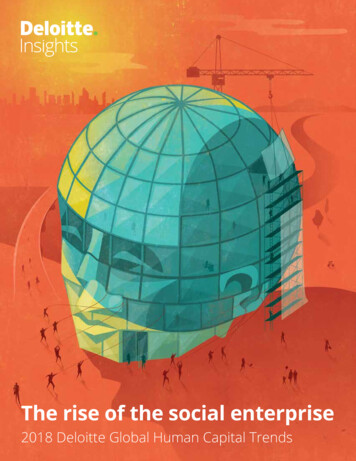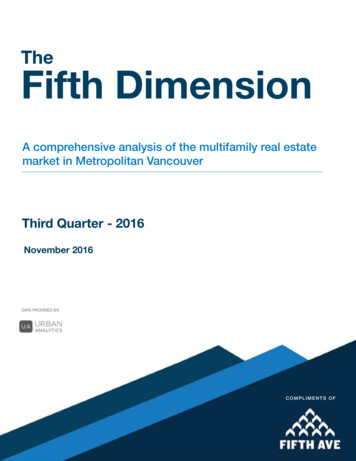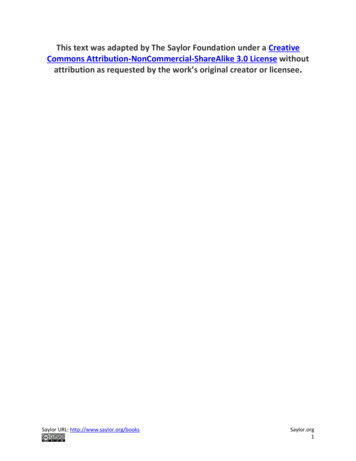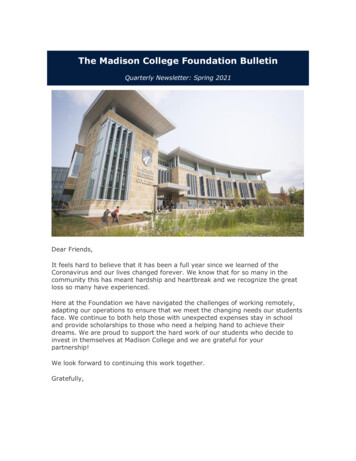
Transcription
The rise of the social enterprise2018 Deloitte Global Human Capital Trends
The rise of the social enterpriseExperience Deloitte’sGlobal Human Capital Trends like neverbefore. Access the new HC Trendsapp featuring exclusive content.Deloitte’s Human Capital professionals leverage research, analytics, and industry insights to helpdesign and execute the HR, talent, leadership, organization, and change programs that enablebusiness performance through people performance. Visit the Human Capital area of www.deloitte.com to learn more.COVER AND CHAPTER ILLUSTRATIONS BY TRACI DABERKO
2018 Deloitte Global Human Capital TrendsCONTENTSINTRODUCTION: THE RISE OF THE SOCIAL ENTERPRISE 2THE SYMPHONIC C-SUITE: TEAMS LEADING TEAMS 17THE WORKFORCE ECOSYSTEM:MANAGING BEYOND THE ENTERPRISE 25NEW REWARDS: PERSONALIZED, AGILE AND HOLISTIC 33FROM CAREERS TO EXPERIENCES: NEW PATHWAYS 41THE LONGEVITY DIVIDEND: WORK IN AN ERA OF 100-YEAR LIVES 49CITIZENSHIP AND SOCIAL IMPACT: SOCIETY HOLDS THE MIRROR 57WELL-BEING: A STRATEGY AND A RESPONSIBILITY 65AI, ROBOTICS, AND AUTOMATION: PUT HUMANS IN THE LOOP 73THE HYPER-CONNECTED WORKPLACE: WILL PRODUCTIVITY REIGN? 81PEOPLE DATA: HOW FAR IS TOO FAR? 891
The rise of the social enterpriseIntroductionThe rise of the social enterpriseThe 2018 Deloitte Global Human Capital Trends report showcases a profound shiftfacing business leaders worldwide: The rapid rise of what we call the social enterprise.This shift reflects the growing importance of social capital in shaping an organization’spurpose, guiding its relationships with stakeholders, and influencing its ultimatesuccess or failure.Irelationships challenges business leaders to listenclosely to constituents, act transparently with information, break down silos to enhance collaboration,and build trust, credibility, and consistency throughtheir actions. This is not a matter of altruism: Doingso is critical to maintaining an organization’s reputation; to attracting, retaining, and engaging criticalworkers; and to cultivating loyalty among customers.N 2018, we are witnessing seismic changes in theworkforce, the workplace, and the technologiesused in the world of work. Based on this year’sglobal survey of more than 11,000 business and HRleaders, as well as interviews with executives fromsome of today’s leading organizations, we believethat a fundamental change is underway. Organizations are no longer assessed based only on traditional metrics such as financial performance, or eventhe quality of their products or services. Rather,organizations today are increasingly judged on thebasis of their relationships with their workers, theircustomers, and their communities, as well as theirimpact on society at large—transforming them frombusiness enterprises into social enterprises.In many ways, social capital is achieving a newfound status next to financial and physical capital invalue. In a recent survey, for instance, 65 percent ofCEOs rated “inclusive growth” as a top-three strategic concern, more than three times greater than theproportion citing “shareholder value.”1 Today, successful businesses must incorporate external trends,perspectives, and voices by maintaining positiverelationships, not just with customers and employees, but also with local communities, regulators,and a variety of other stakeholders. Building theseWHAT IS A SOCIAL ENTERPRISE?A social enterprise is an organization whosemission combines revenue growth and profitmaking with the need to respect and supportits environment and stakeholder network. Thisincludes listening to, investing in, and activelymanaging the trends that are shaping today’sworld. It is an organization that shouldersits responsibility to be a good citizen (bothinside and outside the organization), servingas a role model for its peers and promoting ahigh degree of collaboration at every level ofthe organization.2
2018 Deloitte Global Human Capital TrendsFigure 1. The evolution of the social enterpriseLEVEL OF EXTERNAL FOCUSEcosystemExternal focusIncreasedengagementwith ionIncreasedcollaborationand internalintegrationEnterpriseInternal focusFunctionalSiloed operatingmodelLEVEL OF COLLABORATIONAND INTERNAL AGILITYSource: Deloitte Global Human Capital Trends survey, 2018.Symphonic“Network of teams”operating modelDeloitte Insights deloitte.com/insightsDespite the economic recovery the world has seensince 2008, many people feel frustrated that financial gains have failed to improve individuals’ lives,address social problems, support political stability,or mitigate technology’s unintended consequences.People today have less trust in their political andsocial institutions than they have in years; many expect business leaders to fill the gap.This point was made this year by BlackRockchief executive Laurence Fink. In his annual letter to CEOs, Fink noted that people are increasingly “turning to the private sector and asking thatcompanies respond to broader societal challenges”and demanding that organizations “serve a socialpurpose.”3 Fink stated that shareholders, including BlackRock itself, are now evaluating companiesbased on this standard. A New York Times reportsuggested that the letter could be a “watershed moment on Wall Street” that raises questions about“the very nature of capitalism.”4In past Global Human Capital Trends reports,we have noted the movement of many organizationstoward a “network of teams” operating model thataims to enable greater collaboration and internalagility.2 Now, this movement has been joined by thegrowing shift from an internal, enterprise focus toan external, ecosystem one (figure 1). Organizationson the leading edge of both of these changes embody our concept of the social enterprise: an organization that is alert enough to sense, and responsiveenough to accommodate, the gamut of stakeholderexpectations and demands.The last decade: Buildingtoward today’s tipping pointWhy has this shift occurred? We believe that itis driven by social, economic, and political changes that have grown since the global financial crisis.3
The rise of the social enterpriseness to fill the void on critical issues such as incomeinequality, health care, diversity, and cybersecurityto help make the world more equal and fair.This expectation is placing immense pressureon companies, but it is also creating opportunities.Organizations that engage with people and demonstrate that they are worthy of trust are burnishingtheir reputation, winning allies, and influencing orsupplanting traditional public policy mechanisms.CEOs such as Amazon’s Jeff Bezos and Salesforce’sMarc Benioff have an unprecedented ability to activate their companies for the good of society.10Consider the organization jointly created by Amazon, Berkshire Hathaway,and JP Morgan Chase tolower health care costsfor employees—tacklingan issue that governmentcannot solve on its own,while also promising todeliver business benefits.11 On the other hand,companies that appearaloof, tone-deaf, or disengaged face harsh headlines, negative attentionon social media, andtough questions from arange of stakeholders.Third, technological change is havingunforeseen impacts on society even as itcreates massive opportunities to achievesustainable, inclusive growth. Advances in artificial intelligence (AI) and new communicationstechnologies are fundamentally changing how workgets done, who does it, and how it influences society.12 For instance, machine learning was not in themainstream three years ago. Today, it is simultaneously one of IT’s hottest areas—and a source of tremendous anxiety about potential job losses. Peopleincreasingly realize that rapid technological change,while holding out the promise of valuable opportunities, also creates unforeseen impacts that canundermine social cohesion. Many stakeholders arealarmed, and they expect businesses to channel thisforce for the broader good.Among the many factors contributing to the riseof the social enterprise, we see three powerful macro forces driving the urgency of this change.First, the power of the individual is growing, with millennials at the forefront. For thefirst time in mature markets, young people believethat their lives will be worse than their parents’—and they are actively questioning the core premisesof corporate behavior and the economic and socialprinciples that guide it.5 Among this group, socialcapital plays an outsized role in where they workand what they buy, and 86 percent of millennialsthink that business success should be measured interms of more than justfinancial performance.6Millennials comprise amajority of the workforce in many countries,and their power will likely grow over time.This shift in powerto the individual is being propelled by today’shyper-connected world,which enables people totrack information aboutcompanies and theirproducts, express theiropinions to a wide audience, and sign onto social movements, globallyand in real time. Back in 2015, we called this trendtoward greater transparency “the naked organization”;7 in 2018, individuals know and expect evenmore from companies than they did three shortyears ago.Second, businesses are being expected tofill a widening leadership vacuum in society.Across the globe, people trust business more thangovernment. The 2018 Edelman Trust Barometerreported that people worldwide place 52 percenttrust in business “to do what is right,” versus just43 percent in government.8 In the United States, inparticular, trust in government has hit a four-yearlow, at just 33 percent.9 There is a widespread perception that political systems are growing more andmore polarized and less and less effective at meeting social challenges. Citizens are looking to busi-People today have lesstrust in their politicaland social institutionsthan they have in years;many expect businessleaders to fill the gap.4
2018 Deloitte Global Human Capital TrendsBecoming a social enterpriseThe good news is that technological advancescan open up new opportunities for businesses tohave a positive impact on society. Reflecting thisview, 87 percent of C-level executives say thatIndustry 4.0—the industrial revolution broughtabout by the combination of digital and physicaltechnologies—will lead to more equality and stability, and 74 percent say business will have moreinfluence than governments or other organizationsto shape this future.13Foundational to behaving as a social enterpriseis to listen carefully to the external as well as the internal environment—not just business partners andcustomers, but all parties in society that an organization influences and is influenced by. In today’sworld, the listening opportunity is greater than everif organizations truly take advantage of the peopledata they have at their fingertips. The increasingly2018’S 10 HUMAN CAPITAL TRENDS: IMPORTANCE AND RESPONDENT READINESSRespondents generally agree that, while each of the following trends is important, most organizations arenot yet ready to meet expectations.Figure 2. Trend importance and readiness85%The symphonicC-suite46%85%People data42%From careersto workplace8%82%45%77%New rewards7%37%Citizenship andsocial impact77%51%AI, robotics,and automation72%31%The longevitydividenedThe workforceecosystem7%34%69%65%30%Very important or importantn 11,070Source: Deloitte Global Human Capital Trends, 2018.Very ready or readyDeloitte Insights deloitte.com/insightsExplore the data further in the Global Human Capital Trends app.5
The rise of the social enterpriseFinally, a social enterprise seeks to actively manage its position in the social ecosystem by engagingwith stakeholders and strategically determiningand pursuing the kind of relationship it wants tomaintain with each. This cannot be done in a siloedway. Hence, this year we have provided a set of actions that C-suite leaders can take related to eachtrend. Each area of focus requires strong collaboration amongst leaders both across the organizationand outside of it. Leaders should form relationshipswith the governments and regulatory bodies thatshape the “rules of the road,” work collaborativelywith them to create and sustain a fair, just, and equitable marketplace, and partner with communitiesand educational institutions to help sustain a steadyflow of talent with the right skills for the organization—and the broader economy—to thrive.hyper-connected nature of the workplace meansthat interactions between and among workers andthe outside world can be a tremendous source foranalysis if managed appropriately. Leaders need totake a proactive approach to managing this wealthof information and leveraging it to keep an eye onthe trends both inside and outside of the workplace.Being a social enterprise also means investingin the broader social ecosystem, starting with anorganization’s own employees. It means treatingall workers—on- and off-balance-sheet—in a fair,transparent, and unbiased way. Leaders shouldseek to provide a work environment that promoteslongevity and well-being, not only in an individual’scareer, but also in the physical, mental, and financial spheres. By doing this, an organization investsboth in its own workforce and in the workforce ecosystem as a whole, which benefits both the organization and society at large.6
2018 Deloitte Global Human Capital Trends2018’s 10 human capital trendsThe power of the individualThe 10 human capital trends we explore in thisyear’s report come together to create an integratedview of the social enterprise.As the power of the individual grows, organizations are revamping their approaches to workforcemanagement, rewards systems, and career modelsto better listen and respond. In particular, as workers and networks outside the organization grow inimportance, companies are striving to build effective ongoing relationships with every segment ofthe workforce ecosystem. In this year’s report, wehave included actions for the individual worker toconsider in influencing and managing their personalization and career experiences. The challenge is tofigure out how to appropriately address each individual’s preferences and priorities while engagingwith a more diverse set of workers and workforcesegments than ever before.From the top: The symphonicC-suiteTREND 1. THE SYMPHONIC C-SUITE:TEAMS LEADING TEAMSBehaving as a social enterprise and managingthe external environment’s macro trends effectivelydemands an unprecedented level of cross-functional vision, connectivity, and collaboration from Csuite leaders. To do this, they must behave as whatwe call the “symphonic C-suite,” in which an organization’s top executives play together as a team whilealso leading their own functional teams, all in harmony. This approach enables the C-suite to understand the many impacts that external forces haveon and within the organization—not just on singlefunctions—and plot coordinated, agile responses.The symphonic C-suite is the next stage in theongoing evolution of leadership models. This newmodel is necessary to help leaders to understand,manage, and respond to the complex social capital issues that organizations face, enabling themto tap opportunities, manage risks, and build relationships with internal and external stakeholders.What’s more, the symphonic leadership model isvital for growth: Our survey finds that respondentswho indicate their C-suite executives “regularly collaborate on long-term interdependent work” are athird more likely to expect their companies to growat 10 percent or more during the next year than respondents whose CxOs operate independently.The C-suite must lead an organization’s response to the other nine trends highlighted in thisreport. The pace and complexity of the changesinvolved, and the high stakes of success or failure,elevate these as C-level issues, which cannot be delegated or approached in silos. Only a symphonic Csuite team is sufficient for the scale and speed of thefollowing nine trends. In our chapter on the symphonic C-suite, we call out specific actions executives can take to drive greater collaboration.TREND 2. THE WORKFORCE ECOSYSTEM:MANAGING BEYOND THE ENTERPRISEBusiness leaders and chief human resources officers (CHROs) recognize the need to actively andstrategically manage relationships with workforcesegments beyond the enterprise, which increasinglyaffect how an organization delivers services and interacts with customers. When asked to forecast themakeup of their workforce in 2020, 37 percent ofsurvey respondents expected a rise in contractors,33 percent foresaw an increase in freelancers, and28 percent expected growth in gig workers. Organizations are finding ways to align their culture andmanagement practices with these external talentsegments—engaging the workforce ecosystem formutual benefit.TREND 3. NEW REWARDS:PERSONALIZED, AGILE, AND HOLISTICLeveraging their power as individuals, employees are asking for more personalized, agile, andholistic rewards, including a focus on fair and openpay. While companies recognize this overall shift,only 8 percent report that their rewards programis “very effective” at creating a personalized, flexible solution. Early experiments are exploring howto develop a holistic variety of rewards and matchthem to individual preferences, across diverse talent segments and on a continuous basis.7
The rise of the social enterpriseTREND 4. FROM CAREERS TOEXPERIENCES: NEW PATHWAYSbrand value, while failure to engage can destroyreputation and alienate key audiences. Many organizations are still catching up: 77 percent of ourrespondents say that citizenship is important, butonly 18 percent say this issue is a top priority reflected in corporate strategy.In a 21st-century career, the individual and hisor her experiences take center stage. Instead of asteady progression along a job-based pathway, leading organizations are shifting toward a model thatempowers individuals to acquire valuable experiences, explore new roles, and continually reinventthemselves. However, 59 percent of our survey respondents rate their organizations as not effectiveor only somewhat effective at empowering peopleto manage their own careers. Improvement in thisarea is essential to attract critical talent, especiallyas technology shifts the skills landscape.TREND 7. WELL-BEING: A STRATEGYAND A RESPONSIBILITYAs the line between work and life blurs further,employees are demanding that organizations expand their benefits offerings to include a wide rangeof programs for physical, mental, financial, and spiritual health. In response, employers are investing inwell-being programs as both a societal responsibility and a talent strategy. More than 50 percent ofsurvey respondents view a variety of such programsas “valuable” or “highly valuable” to employees, butbig gaps remain between what employees value andwhat companies are delivering.Filling society’s leadership vacuumLeading companies are developing strategies thataddress societal concerns such as longevity and wellbeing—and doing so in ways that help improve productivity and performance. Those in this vanguardare finding rich opportunities to build social capitaland become a leading voice on key societal issues.Leveraging technology forsustainable growthTREND 5. THE LONGEVITY DIVIDEND:WORK IN AN ERA OF 100-YEAR LIVESOrganizations are looking to capitalize on thebenefits of a surge of new AI-based software, robotics, workplace connectivity tools, and peopledata applications, while also mitigating potentialdownsides and unforeseen effects. These tools andinvestments can help to redesign work architecture,lift productivity, and enhance people efforts, but organizations must also pay attention to and respecttheir impacts on the workforce as a whole.Forward-looking organizations see extendedlongevity and population aging as an opportunity.Twenty percent of this year’s survey respondentssaid that they are partnering with older workersto develop new career models. This longevity dividend enables companies to both address a pressing societal issue and tap into a proven, committed,and diverse set of workers. However, doing this requires innovative practices and policies to supportextended careers, as well as collaboration betweenbusiness leaders and workers, to tackle shared challenges such as age bias and pension shortfalls.TREND 8. AI, ROBOTICS, AND AUTOMATION:PUT HUMANS IN THE LOOPThe influx of AI, robotics, and automation intothe workplace has dramatically accelerated in thelast year, transforming in-demand roles and skillsinside and outside organizations. Perhaps surprisingly, those roles and skills focus on the “uniquelyhuman” rather than the purely technical: Surveyrespondents predict tremendous future demandfor skills such as complex problem-solving (63percent), cognitive abilities (55 percent), and social skills (52 percent). To be able to maximize thepotential value of these technologies today andTREND 6. CITIZENSHIP AND SOCIALIMPACT: SOCIETY HOLDS THE MIRRORAn organization’s track record of corporate citizenship and social impact now has a direct bearingon its core identity and strategy. Engagement withother stakeholders on topics such as diversity, gender pay equity, income inequality, immigration, andclimate change can lift financial performance and8
2018 Deloitte Global Human Capital Trendsgenerated rich opportunities for HR and organizations—but they are now also generating a varietyof potential risks. While more than half of our survey respondents are actively managing the risk ofemployee perceptions of personal data use, and asimilar proportion is managing the risk of legal liability, only a quarter are managing the impact ontheir consumer brand. Organizations face a tippingpoint: Develop a set of well-defined policies, security safeguards, transparency measures, and ongoing communication around the use of people data,or risk employee, customer, and societal backlash.minimize the potential adverse impacts on theworkforce tomorrow, organizations must put humans in the loop—reconstructing work, retraining people, and rearranging the organization. Thegreatest opportunity is not just to redesign jobs orautomate routine work, but to fundamentally rethink “work architecture” to benefit organizations,teams, and individuals.TREND 9. THE HYPER-CONNECTEDWORKPLACE: WILL PRODUCTIVITY REIGN?New communications tools are rapidly enteringthe workplace. Seventy percent of respondents believe workers will spend more time on collaborationplatforms in the future, 67 percent see growth in“work-based social media,” and 62 percent predictan increase in instant messaging. But as these toolsmigrate from personal life to the workplace, organizations must apply their expertise in team management, goal-setting, and employee developmentto ensure that they actually improve organizational,team, and individual performance and promote thenecessary collaboration to truly become a social enterprise. Like the outside world, organizations arebecoming hyper-connected; can they also becomehyper-productive?A call to actionThe 2018 Global Human Capital Trends reportsounds a wake-up call for organizations. The rise ofthe social enterprise requires a determined focuson building social capital by engaging with diversestakeholders, accounting for external trends, creating a sense of mission and purpose throughout theorganization, and devising strategies that managenew societal expectations. At stake is nothing lessthan an organization’s reputation, relationships,and, ultimately, success or failure.In this new era, human capital is inextricablytied to social capital. This reality demands a fundamental pivot in how organizations do business today—and how they prepare for the human capitalchallenges of the future.TREND 10. PEOPLE DATA:HOW FAR IS TOO FAR?The rapid increase in data availability and theadvent of powerful people analytics tools have9
The rise of the social enterpriseAppendix A: Trend importance by region,industry, and organization sizeTable 1. Trend importance by regionGlobalAmericasLatin &SouthAmericaNorthAmericaEurope, Middle East & AfricaAsia PacificAfricaCentral peAsiaOceaniaThe %76.9%90.6%88.3%People 5.6%From careersto %83.3%80.1%91.6%86.6%The .9%84.3%78.9%83.6%89.0%New 5%65.6%Citizenshipand 0%83.0%82.8%AI, 5%83.0%69.2%84.1%73.2%The 8%69.2%76.5%66.7%The .0%60.1%76.5%61.5%n 11,070Note: Figures represent the percentage of respondents rating each trend “important” or “very important.”Source: Deloitte Global Human Capital Trends survey, 2018.10
2018 Deloitte Global Human Capital TrendsTable 2. Trend importance by industryAllConsumer Energy & FinancialLifeManufac- Profession- Publicindustries business resources services sciences turing al services sectorRealestateTech,media &telecommunicationsThe %77.1%82.6%87.4%People 9.8%From careersto %83.5%79.7%88.1%86.5%The .4%86.2%77.0%81.1%90.0%New 6%80.2%Citizenship andsocial %75.9%AI, 7%71.0%55.9%65.2%77.0%The 0%69.7%76.1%65.7%The .0%58.9%66.2%69.3%n 11,070Note: Figures represent the percentage of respondents rating each trend “important” or “very important.”Source: Deloitte Global Human Capital Trends survey, 2018.11
The rise of the social enterpriseTable 3. Trend importance by organization size (number of employees)All respondentsLarge (10,001 )Medium (1,001to 10,000)Small (1,000or fewer)The symphonic C-suite85.0%84.1%85.2%85.3%People data84.8%88.3%86.4%82.2%From careers to %83.9%83.8%The hyper-connectedworkplace82.1%84.7%81.1%81.5%New rewards77.4%73.5%76.8%79.5%Citizenship and social impact76.7%81.7%77.7%73.7%AI, robotics, and automation72.4%82.4%73.0%67.4%The longevity dividend69.1%69.5%69.2%68.8%The workforce ecosystem65.4%64.7%62.9%67.2%n 11,070Note: Figures represent the percentage of respondents rating each trend “important” or “very important.”Source: Deloitte Global Human Capital Trends survey, 2018.Appendix B: Survey demographicsFigure 3. Respondents by regionOceaniaMiddle EastNordic countriesAfricaCentral &Eastern Europe3%4%7%5%6%7%9%North America8%15%Latin &South America16%Asia19%Western Europe23%n 11,070Source: Deloitte Global Human Capital Trends survey, 2018.12Deloitte Insights deloitte.com/insights
2018 Deloitte Global Human Capital TrendsFigure 4. Respondents by industryProfessional services15%Technology, media &telecommunications13%Financial services13%Consumer business13%Manufacturing11%Energy & resources9%Public sector8%Life sciencesReal estate6%2%11%Othern 11,070Source: Deloitte Global Human Capital Trends survey, 2018.Figure 5. Respondents by organizationsize (number of employees)Deloitte Insights deloitte.com/insightsFigure 6. Respondents by job function24%38%49%62%27%1,000 or fewer employeesHR1,001 to 10,000 employeesNon-HR10,001 employeesn 11,070Source: Deloitte Global Human Capital Trendssurvey, 2018.n 11,070Source: Deloitte Global Human Capital Trendssurvey, 2018.Deloitte Insights deloitte.com/insightsDeloitte Insights deloitte.com/insights13
The rise of the social enterpriseTable 4. Country in which respondent worksFigure 7. Respondents by level10%United 29Mexico407South idual contributorFrance261Vice d212United Kingdom202Poland198Turkey161Ukraine160Russian lands136Costa Rica133Uruguay126Greece125United Arab Emirates108Italy106Nigeria10233%n 11,070Source: Deloitte Global Human Capital Trendssurvey, 2018.Deloitte Insights deloitte.com/insightsOther2,055Total11,070Source: Deloitte Global Human Capital Trends survey,2018.14
2018 Deloitte Global Human Capital TrendsENDNOTES1.Deloitte, The business case for inclusive growth: Deloitte Global’s inclusive growth survey report, January 2018.2.Tiffany McDowell, Dimple Agarwal, Don Miller, Tsutomu Okamoto, and Trevor Page, Organizational design: Therise of teams, Deloitte University Press, February 29, 2016; Josh Bersin, Tiffany McDowell, Amir Rahnema, andYves Van Durme, The organization of the future: Arriving now, Deloitte University Press, February 28, 2017.3.Larry Fink, “Larry Fink’s annual letter to CEOs: A sense of purpose,” BlackRock, accessed January 30, 2018.4.Andrew Ross Sorkin, “BlackRock’s message: Contribute to society, or risk losing our support,” New York Times,January 15, 2018.5.Deloitte, The 2017 Deloitte millennial survey: Apprehensive millennials: Seeking stability and opportunities in anuncertain world, 2017.6.Ibid.7.David Brown et al., Culture and engagement: The naked organization, Deloitte Insights, February 27, 2015.8.Edelman, 2018 Edelman Trust Barometer: Global Report, 2018, p. 5.9.Ibid., p. 11.10. Marc Benioff, “Marc Benioff on inequality in an age of innovation,”
This point was made this year by BlackRock chief executive Laurence Fink. In his annual let-ter to CEOs, Fink noted that people are increas-ingly "turning to the private sector and asking that companies respond to broader societal challenges" and demanding that organizations "serve a social purpose."3 Fink stated that shareholders, includ-











